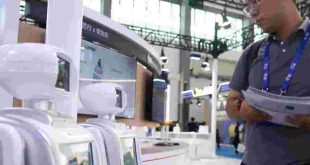Introduction to the Intersection of Text and Technology
Text and technology have always shared a dynamic relationship. From the first written words etched on stone tablets to the digital texts that fill our screens today, this connection has transformed how we create, consume, and understand language. The concept of “Technotext” emerges at this intersection, blending literature with modern technological advancements. In an age where smartphones and social media dominate our communication landscape, exploring how text interacts with technology becomes increasingly vital.
This blog will delve into the multifaceted nature of Technotext across literature, linguistics, and media studies. We will uncover its historical evolution from print to pixels and examine how technology enhances language learning while reshaping media consumption trends. With ethical considerations in mind, we’ll explore successful case studies showcasing innovative integrations of text and tech.
Join us as we navigate through these intriguing landscapes where aesthetics meet labor in the realm of Artificial Intelligence (AI). Get ready for an enlightening journey!
History of Technotext in Literature: From Paper to Digital Age
The journey of technotext in literature mirrors the evolution of our society’s relationship with technology. Initially, texts were confined to paper—ink on pages that shaped cultures and ideas. This traditional medium created a tactile connection between readers and words.
As the digital age dawned, literature transformed dramatically. E-books emerged, providing access to vast libraries at our fingertips. The joy of reading became portable, changing where and how we consume stories.
Emerging technologies like hypertext introduced non-linear narratives, allowing readers to navigate stories in ways previously unimaginable. Literature began to blend with interactive elements, creating immersive experiences.
This shift has redefined authorship too. Writers now leverage blogs and social media platforms for immediate feedback and engagement with audiences. The lines blur between creators and consumers as everyone contributes to the literary landscape.
Technotext has thus become a vibrant tapestry interwoven with bytes and pixels alongside ink—a reflection of contemporary life itself.
The Role of Technology in Linguistics: Enhancing Language Learning and Analysis
Technology revolutionizes linguistics, making language learning more accessible and engaging. With tools like mobile apps and online courses, learners can study at their own pace. These platforms often incorporate gamification elements that boost motivation.
Beyond mere vocabulary acquisition, technology enables deep analysis of linguistic structures. Advanced software facilitates real-time transcription and translation services. This allows for greater understanding of nuances across languages.
Moreover, machine learning algorithms analyze vast amounts of data to uncover patterns in language use. Researchers benefit from insights that were once time-consuming or impossible to gather.
Interactive forums enhance collaboration among linguists globally. Sharing knowledge becomes effortless as scholars exchange findings instantaneously.
The integration of technology into linguistics enriches both education and research, paving the way for innovative practices in language studies.
Impact of Technology on Media: From Print to Social Media
The evolution of media has undergone a remarkable transformation with the advent of technology. Print once dominated, offering tangible newspapers and books to readers. The tactile experience was cherished, yet limited by distribution challenges.
Enter the digital age. Social media platforms exploded onto the scene, shifting how we consume information. News travels faster than ever before—often in real-time and from various sources.
Engagement has also changed dramatically. Audiences can interact directly with content creators, fostering a dynamic conversation that print could never facilitate. This immediacy reshapes public discourse daily.
However, this shift brings complexities too—misinformation spreads just as quickly as credible news does. Navigating this landscape requires critical thinking skills from consumers.
As technology continues to advance, its influence on media will only grow deeper and more intricate—a fascinating journey worth observing closely.
Ethical Considerations in the Use of Technology for Text Creation and Consumption
The rise of technotext brings with it a myriad of ethical considerations. As technology reshapes how we create and consume text, questions about authorship and originality become paramount.
With AI-generated content on the rise, who truly owns a piece? This challenges traditional notions of intellectual property and raises concerns about plagiarism.
Moreover, accessibility plays a critical role in this discussion. While digital platforms can democratize information sharing, they also risk excluding those without the necessary tools or skills to engage effectively.
There’s also the influence of algorithms shaping what texts are seen by audiences. These hidden systems can reinforce biases or limit exposure to diverse perspectives.
It’s essential for creators and consumers alike to remain vigilant about these issues as they navigate this evolving landscape. The conversation surrounding ethics must keep pace with technological advancements in literature and linguistics.
Case Studies: Successful Integration of Text and Technology
One remarkable case study is the use of augmented reality (AR) in storytelling. Projects like “The Walking Dead: Our World” have blended traditional narratives with interactive elements, allowing readers to engage with characters and environments in real-time. This integration brings stories to life, creating immersive experiences that capture attention.
Another example can be found in educational platforms such as Duolingo. They employ gamification techniques alongside linguistic insights, making language learning engaging and effective. Users learn through bite-sized lessons while competing against friends, merging technology with linguistics seamlessly.
In media studies, Twitter has transformed how news is disseminated. Journalists now share updates instantly via text-based posts, breaking traditional barriers of reporting timeframes. This shift not only speeds up information flow but also invites public interaction and feedback on current events.
These cases illustrate just a few ways technotext reshapes our understanding of literature, linguistics, and media today.
Future Directions and Possibilities for Technotext
The future of Technotext holds exciting potential. Innovations in artificial intelligence are poised to reshape how we create and interact with text. Imagine personalized narratives crafted by algorithms that adapt to individual preferences.
As virtual reality advances, the reading experience could transform into immersive journeys. Readers might step inside stories, engaging with characters and settings like never before.
Linguistics will also benefit from technology’s evolution. Adaptive language tools can support learners from diverse backgrounds, making education more inclusive.
Social media platforms may evolve further as arenas for literary expression, where micro-narratives gain traction alongside traditional forms. These spaces allow diverse voices to emerge and flourish.
Ethics will remain a focal point as we navigate issues around authorship and originality within this new landscape. Collaboration between creators, technologists, and ethicists will be vital for harmonious progression in literature and technology alike.
Conclusion
The interplay between text and technology continues to reshape our understanding of literature, linguistics, and media. As we explore the history of technotext, it becomes evident that the evolution from paper to digital formats has profoundly influenced how stories are told and received. This transformation invites us to reconsider traditional narratives in light of new possibilities.
In linguistics, technological advancements have opened up innovative avenues for language learning and analysis. Tools such as language apps and AI-driven analytics allow learners to engage with languages more interactively than ever before. The fusion of technology with linguistic study enhances both teaching methodologies and research capabilities.
When examining media studies, the shift from print to social platforms highlights significant changes in content creation and consumption. Social media not only democratizes information but also challenges conventional publishing paradigms by giving voice to diverse perspectives.
Ethical considerations around technotext warrant careful thought as well. Issues like copyright infringement, data privacy, and misinformation demand ongoing dialogue among creators, consumers, and policymakers alike. Addressing these concerns ensures a responsible approach toward emerging technologies in text creation.
Case studies showcase successful integrations where creativity meets innovation—whether through multimedia storytelling or interactive educational tools that utilize cutting-edge tech to foster engagement.
Looking ahead reveals exciting prospects for further development within technotext frameworks across various domains including literature’s aesthetics or AI’s role labor dynamics within creative industries. New technologies promise richer experiences while inviting writers, educators, scholars—and audiences—to participate actively in shaping this evolving landscape.
As we navigate this complex terrain together—embracing opportunities presented by technological advancements—we stand on the brink of a transformative era that will redefine our relationships with texts across all spheres of life.
 Clicksud
Clicksud


